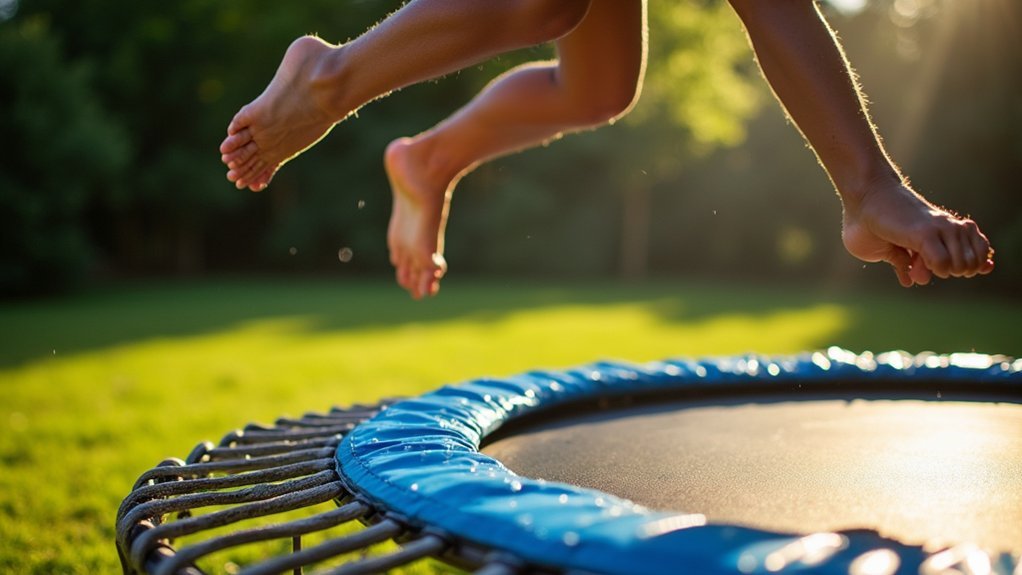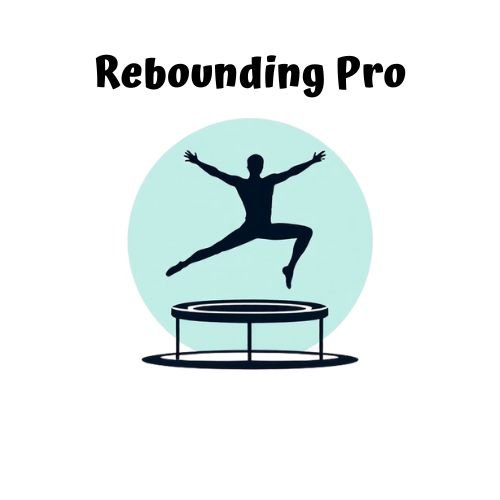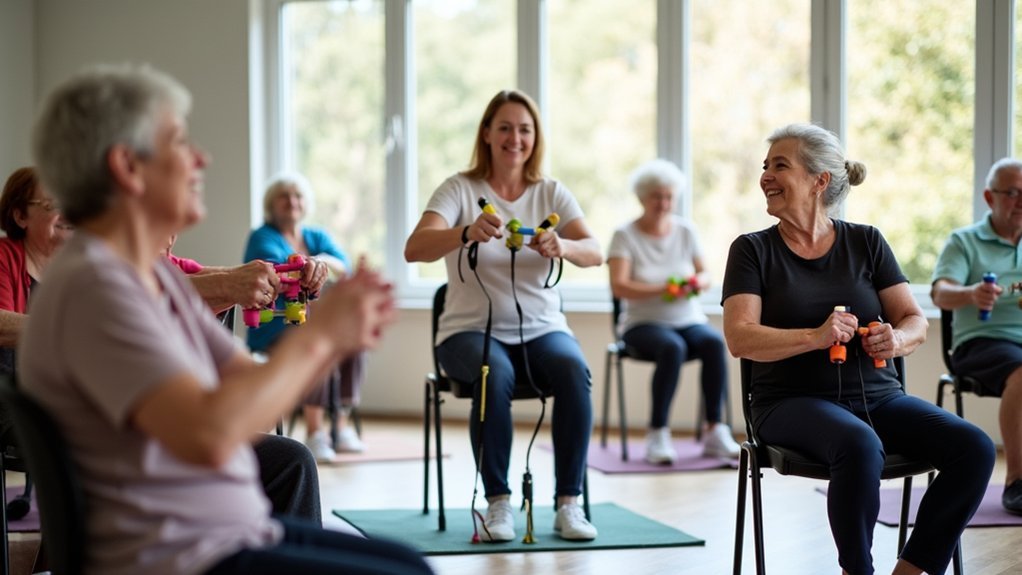Science validates rebounding for cellulite reduction because it effectively stimulates lymphatic drainage through alternating gravitational forces. This unique exercise creates compression-decompression cycles that strengthen cell membranes and improve circulation to cellulite-prone areas. You’ll experience enhanced waste removal, increased collagen production, and improved skin elasticity with consistent practice. Unlike traditional exercises, rebounding’s 0-3G cycles specifically target the cellular mechanisms that contribute to cellulite formation. The evidence behind this simple yet powerful technique reveals why it outperforms conventional treatments.
The Science Behind Cellulite Formation

While many consider cellulite merely a cosmetic concern, its formation stems from complex structural interactions beneath your skin. What you’re seeing is actually fat lobules protruding through your dermis, creating that characteristic dimpled appearance.
Women experience cellulite more frequently due to their vertical connective tissue arrangement, unlike men’s crisscross pattern that provides better containment. This structural difference creates a perfect environment for fat herniation when force imbalances occur between outward adipose pressure and inward dermal restraint.
Your hormones play an essential role too. Estrogen increases fat storage sensitivity, particularly during adolescence and pregnancy, while potentially suppressing connective tissue repair.
When combined with weakened subdermal junctions, reduced skin elasticity, and genetic predispositions for superficial fat storage, you have the perfect recipe for cellulite development.
How Rebounding Activates Lymphatic Drainage
When you bounce on a rebounder, your lymphatic system kicks into high gear, accelerating the removal of waste trapped beneath your skin that contributes to cellulite.
The alternating gravitational forces you experience during rebounding expand and contract your lymphatic vessels, enhancing fluid flow throughout your body.
This rhythmic bouncing activates millions of one-way valves in your lymphatic system, helping eliminate toxins that would otherwise accumulate in fatty tissues. The gentle bouncing creates twice the force of gravity upon landing, making it more effective than running for stimulating lymphatic circulation.
Waste Removal Acceleration
The human body’s natural waste removal system gets a significant boost through rebounding exercises that specifically target lymphatic circulation.
Unlike blood, lymph fluid lacks a pump and relies on muscle contractions and gravitational changes to move effectively.
When you rebound, you create alternating states of weightlessness and double gravity that force lymph valves to open and close simultaneously. This pumping action accelerates toxin movement toward elimination pathways.
The rhythmic up-and-down motion engages multiple muscle groups, creating a full-body pumping effect that stimulates lymph nodes to filter waste more efficiently.
Regular rebounding sessions enhance oxygen delivery to tissues while supporting immune function through improved waste removal. The gentle bouncing creates muscle pumping action that helps combat lymphatic dysfunction common in individuals with cellulite.
As your lymphatic system becomes more efficient, accumulated toxins that contribute to cellulite formation are more rapidly cleared from your body.
Fluid Flow Enhancement
Unlike conventional cardiovascular exercises, rebounding creates a unique physiological environment that dramatically enhances lymphatic fluid movement throughout your body.
When you bounce, you generate alternating weightlessness and gravitational force that optimizes lymphatic valve operation.
Each rebound produces a fluid shift as G-force shifts mobilize interstitial fluids toward drainage nodes. Your body’s lymphangions contract more efficiently during these acceleration/deceleration phases, increasing overall lymph velocity.
The multi-directional movements you make while rebounding—twisting, side-to-side motions—specifically target drainage pathways in your lateral torso and limbs.
This repeated micro-movement achieves significant fluid transport without cardiovascular strain, breaking down fascial restrictions that typically impede proper drainage in cellulite-prone areas.
The rhythmic pressure changes also prevent fluid entrapment in hypodermal layers where cellulite forms. Studies show this exercise helps reduce the appearance of cellulite by decreasing swelling and fluid retention in affected areas.
Toxin Elimination Process
At the core of rebounding’s cellulite-fighting power lies its remarkable ability to activate your body’s natural detoxification pathways. The rhythmic bouncing motion creates a pumping effect on your lymphatic system, enhancing toxin removal from areas where cellulite typically appears. Studies show that the gentle, consistent movement during rebounding sessions is particularly effective for supporting long-term lymphatic health and cellulite reduction.
| Rebounding Action | Detoxification Effect |
|---|---|
| Up-down motion | Increases lymphatic valve activity |
| Muscle contraction | Pumps lymph fluid more efficiently |
| Increased circulation | Delivers oxygen to skin tissues |
| Stimulated lymph nodes | Enhances filtering of toxins |
| Whole-body engagement | Maximizes lymphatic drainage |
When you bounce, you’re fundamentally opening and closing these lymphatic valves repeatedly, creating a powerful flush throughout your system. This enhanced flow carries toxins away from your skin’s surface to elimination organs, reducing inflammation and improving skin texture where cellulite appears.
Cellular Impact: Rebounding vs. Traditional Exercises
Your body’s cells respond to rebounding’s unique G-force differently than they do to traditional exercises, experiencing alternating weightlessness and increased gravitational pull with each bounce.
This cellular bounce response activates specialized mechanoreceptors that trigger accelerated waste removal and nutrient delivery throughout tissue layers affected by cellulite.
Unlike standard workouts, rebounding creates adaptive tissue responses through rhythmic compression-decompression cycles that simultaneously strengthen cell membranes while improving intercellular communication essential for breaking down stubborn fat deposits. Regular participation in this activity can complement specific exercises for cellulite reduction like curtsy lunges and glute bridges.
Cellular Bounce Response
When you bounce on a mini-trampoline, your body experiences a unique cellular response that traditional exercises simply can’t replicate.
Each bounce creates alternating forces of weightlessness and increased gravity, opening and closing lymphatic valves throughout your body.
This rhythmic bouncing stimulates cellular detoxification pathways more efficiently than static exercises, allowing your body to flush toxins that contribute to cellulite formation.
The gentle pressure changes massage your tissues at the cellular level, improving blood circulation to areas prone to cellulite while strengthening surrounding muscles.
Your cells fundamentally receive an extensive workout – they’re compressed and expanded with each bounce, enhancing oxygen delivery and waste removal.
This cellular stimulation promotes healthier, more resilient tissue that’s less likely to display the dimpled appearance of cellulite.
NASA research confirms that rebounding creates up to 68% more effective exercise benefits compared to running with less joint stress.
G-Force Adaptive Tissue
The extraordinary cellular benefits of rebounding extend even deeper when examining how your body responds to G-force variations.
Unlike traditional exercises that generate mostly unidirectional forces below 2G, rebounding creates rhythmic 0-3G cycles that dramatically enhance cellular function.
These alternating compression-decompression patterns trigger essential adaptive responses in your tissues. Your cells experience dynamic cytoskeletal reorganization as actin filaments realign, activating mechanotransduction pathways that traditional exercises simply can’t match.
Meanwhile, the pulsatile fluid dynamics improve interstitial circulation and metabolite clearance.
When you rebound, your tissues receive precisely the mechanical variety needed to stimulate integrin clustering and focal adhesion maturation.
This strengthens cytoskeleton-ECM signaling networks while promoting lymphatic drainage—all key factors in breaking down the fibrous patterns associated with cellulite.
Research-Backed Circulation Benefits

Scientific evidence strongly supports rebounding as an effective method for enhancing both blood and lymphatic circulation, which directly impacts cellulite appearance.
When you rebound, you’re activating a powerful two-pronged approach to cellulite reduction through enhanced circulatory effects.
- Accelerated toxin removal occurs as lymphatic valves are stimulated, directly addressing fluid retention that contributes to cellulite’s dimpled appearance.
- Increased oxygenated blood delivery to subcutaneous tissues revitalizes cellulite-prone areas and supports fat metabolism.
- Capillary network expansion improves nutrient delivery while simultaneously clearing metabolic waste products.
- Inflammation reduction results from improved circulatory efficiency, decreasing factors that worsen cellulite visibility.
These circulation benefits aren’t just theoretical—they’re backed by clinical observations comparing rebounding to traditional exercises like running.
Measurable Changes in Skin Elasticity
Regular rebounding exercise can greatly boost your body’s collagen production, a critical protein that maintains skin elasticity and firmness.
You’ll notice measurable improvements in skin tension as this increased collagen strengthens the underlying structure that prevents dimpling and sagging.
These changes can be tracked through before-and-after skin elasticity tests, where many rebounders report visible firmness improvements within 8-12 weeks of consistent practice.
Collagen Production Increase
Significant improvements in skin elasticity occur when rebounding stimulates collagen production, an essential protein responsible for skin’s structure and firmness.
When you bounce regularly, you’re enhancing blood circulation, delivering crucial nutrients to skin cells that support collagen synthesis.
Your rebounding routine creates multiple physiological benefits for collagen:
- Reduces cortisol levels that typically suppress collagen production
- Enhances elasticity in fascia, the collagen-rich connective tissue
- Improves lymphatic drainage, removing toxins that damage skin
- Increases oxygen supply to skin cells, fueling collagen formation
This increased collagen production directly combats the “orange peel” appearance of cellulite by tightening skin and improving its overall structure.
The strengthened muscles from rebounding further contribute to smoother, firmer skin with sustained elasticity over time. Just 10 minutes of daily rebounding effectively promotes blood circulation improvement, which is fundamental to reducing the visibility of cellulite and enhancing overall skin health.
Measuring Skin Firmness
While anecdotal reports of improved skin firmness are valuable, objective measurements provide concrete evidence of rebounding’s impact on cellulite reduction. Clinical studies track these improvements using specialized tools like cutometers that measure skin elasticity through suction deformation, quantifying firmness (R0) and elasticity (R2) parameters.
High-frequency ultrasound visualizes structural changes beneath the skin’s surface, revealing increased dermal thickness and reduced fat protrusions — key biomarkers of cellulite improvement. Research shows measurable changes typically appear between weeks 2-4, with statistically significant elasticity gains by week 8. Unlike some methods such as Endermologie® that require continued sessions for temporary results, rebounding may provide more sustainable benefits.
The most compelling data comes from standardized evaluation methods: elastographic strain ratios demonstrate improved tissue stiffness, while blinded photographic analysis eliminates observer bias.
These objective measurements confirm what you’re feeling subjectively — rebounding creates quantifiable improvements in skin firmness.
The Metabolic Advantage of Mini-Trampoline Workouts

Bouncing on a mini-trampoline doesn’t just feel fun—it transforms your metabolic engine in ways few other exercises can match.
Your body experiences a unique metabolic boost that continues burning calories even after you’ve finished your session.
What makes rebounding uniquely effective for addressing cellulite is its powerful metabolic impact:
- Engages in Metabolic Enhanced Interval Training (MEIT) which maximizes fat burning while preserving muscle mass
- Supercharges your metabolism without the joint stress of high-impact exercises
- Burns calories efficiently while improving circulation to problem areas
- Activates multiple muscle groups simultaneously, creating a thorough metabolic effect
The 25-minute rebounding workout format with 50 seconds on, 10 seconds off intervals provides optimal metabolic conditioning while making the exercise accessible for all fitness levels.
You’ll enjoy these benefits regardless of your fitness level, as the mini-trampoline allows you to easily adjust intensity to match your needs.
Clinical Studies on Rebounding and Body Composition
Scientific research confirms that rebounding workouts considerably improve your body composition, with studies showing measurable reductions in fat mass and gains in lean muscle.
You’ll find that mini-trampoline exercise consistently leads to decreased BMI and reduced body circumferences, particularly beneficial for those targeting cellulite-prone areas.
These clinical outcomes aren’t just anecdotal—they’re documented across multiple studies where participants experienced positive anthropometric changes alongside improved cardiovascular health markers. Meeting ACSM guidelines for cardiorespiratory fitness, mini-trampoline workouts simultaneously burn significant calories while engaging multiple muscle groups.
Evidence From Research
Although often dismissed as merely recreational, rebounding has garnered considerable scientific attention for its body composition benefits.
Multiple 12-week studies demonstrate that just three rebounding sessions weekly can markedly reduce body fat percentage, particularly in women. Research shows mini-trampoline training actually outperforms running for fat reduction in young men.
- Four-week programs yield measurable improvements in BMI and waist-hip ratio compared to control groups.
- Rebounding preserves lean muscle mass while specifically targeting fat reduction.
- Consistency matters more than duration—three weekly sessions improve body composition regardless of length.
- Both water-based and land-based rebounding protocols enhance body composition outcomes in adults.
This scientific validation confirms what rebounders have long claimed: these fun, bouncy workouts offer serious results for cellulite reduction through targeted fat loss.
Measurements of Improvement
Clinical assessments provide quantifiable proof of rebounding’s effectiveness for cellulite reduction.
When you incorporate rebounding into your routine, you’ll experience significant anthropometric changes, including reduced circumferences in problematic areas where cellulite often appears.
Research demonstrates that rebounding increases lean muscle mass while simultaneously decreasing fat mass—a vital combination for diminishing cellulite’s dimpled appearance.
The enhanced lymphatic flow from rebounding directly targets fluid retention that contributes to cellulite visibility. The increased lymphatic circulation helps flush out toxins that can exacerbate cellulite formation and appearance.
Beyond cosmetic benefits, you’ll notice improvements in blood pressure, metabolic markers, and cardiovascular fitness.
Your lipid and glucose profiles will enhance, contributing to overall health while addressing cellulite concerns.
The increased work capacity and VO2max you’ll develop further supports your body’s ability to metabolize fat in cellulite-prone areas.
Physiological Mechanisms of Toxin Elimination
When the body engages in rebounding exercise, multiple physiological systems activate to eliminate toxins that contribute to cellulite formation. The up-and-down motion creates a pump-like effect, enhancing your lymphatic circulation—the body’s natural detoxification highway.
Your body leverages four key pathways during rebounding:
- Liver processing: Phase I and II enzymes transform fat-soluble toxins into water-soluble compounds for elimination.
- Kidney filtration: Increased blood flow enhances glomerular filtration and toxic waste removal.
- Sweat excretion: Integumentary system releases heavy metals and waste through perspiration.
- Lymphatic flow: Rebounding creates a gravitational vacuum that pulls stagnant lymph fluid through one-way valves.
This multi-system approach explains why rebounding produces visible cellulite reduction more effectively than stationary exercises.
Collagen Production and Rebounding Correlation
Rebounding exercises stimulate collagen production through a fascinating biomechanical process that directly impacts your skin’s structure and appearance. When you bounce, the increased circulation delivers more nutrients and oxygen to your skin cells, enhancing collagen synthesis—the protein responsible for your skin’s elasticity and firmness.
As you rebound regularly, you’ll notice improved skin texture as collagen fibers strengthen the underlying connective tissue. This process helps reduce the appearance of cellulite by tightening skin that may otherwise appear dimpled or saggy.
Your lymphatic system simultaneously removes toxins that can damage collagen, creating ideal conditions for new production.
For maximum benefits, combine your rebounding routine with proper hydration and nutrition. While genetics influence your individual results, consistent rebounding can considerably improve your skin’s collagen structure and overall appearance.
Hormonal Regulation Through Bounce Training
Hormonal balance plays a pivotal role in cellulite formation, making bounce training an effective intervention for those struggling with this common concern. When you rebound, you’re actively combating the estrogen decline that increases cellulite visibility while stimulating your thyroid to regulate metabolism. This dynamic movement provides extensive hormonal benefits that static exercises simply can’t match.
Rebounding rebalances your hormones at the cellular level, directly targeting the root causes of stubborn cellulite.
- Your lymphatic system pumps more efficiently during rebounding, removing excess hormones and toxins that contribute to cellulite’s dimpled appearance.
- Rebounding naturally lowers cortisol levels through endorphin release, reducing stress-related fat storage in your lower body.
- The vertical motion specifically targets hormone-sensitive areas like thighs and hips where estrogen dominance causes fat retention.
- Just 15 minutes of rebounding activates a multi-gland hormonal response superior to longer traditional workouts.
Comparative Analysis With Other Cellulite Treatments
Among the vast landscape of cellulite treatments available today, rebounding stands out as uniquely effective due to its multifaceted approach to addressing the root causes of dimpled skin.
Unlike topical treatments that temporarily tighten skin or expensive clinical procedures with minimal lasting effects, rebounding delivers visible results within 2-3 weeks of daily 10-minute sessions.
You’ll find rebounding remarkably cost-effective—a one-time investment of $50-$300 compared to recurring expenses for creams ($20-$100/month) or clinical treatments ($200-$2,000/session).
While laser therapies and liposuction carry risks of scarring, burns, and contour irregularities, rebounding offers joint-friendly exercise with additional pelvic floor strengthening benefits.
Most importantly, rebounding’s effects build over time, unlike topicals that lose effectiveness upon discontinuation or surgical options that degrade with age.
Optimal Rebounding Protocols for Visible Results
To maximize cellulite reduction through rebounding, you’ll need to follow specific protocols that target the underlying causes of dimpled skin.
The science-backed approach combines lymphatic activation with targeted muscle engagement to break down fat deposits while improving circulation.
Rebounding targets cellulite at its source through dual-action lymphatic stimulation and focused muscle engagement.
- Commit to 10-15 minute daily sessions, with 3-4 weekly focused 20-minute workouts for visible results within 4-6 weeks
- Alternate between gentle bouncing (stimulating lymphatic flow) and higher intensity intervals that create 4x gravitational load on cells
- Incorporate twist jumps and squat bounces that specifically target cellulite-prone areas while engaging multiple muscle groups
- Schedule morning sessions when possible to capitalize on peak thyroid hormone activity, and stay hydrated to support toxin elimination
Studies show that approximately 80% of resolutions fail by February, so creating measurable and achievable rebounding goals is essential for long-term success with cellulite reduction.
Tracking Progress: Scientific Markers of Improvement
Tracking your rebounding journey requires more than just looking in the mirror for visible changes. Objective measures provide clearer feedback on your progress against cellulite.
Monitor circumference measurements at problem areas, as reduced measurements correlate with cellulite improvement. Bioelectrical impedance readings can track decreasing body fat percentages, which often translate to smoother skin appearance.
Look for reduced edema and fluid retention—key indicators that your lymphatic system is functioning better. Improved skin elasticity, which you can observe by pinching and releasing skin, signals enhanced circulation and collagen activity.
Documentation through standardized photography in consistent lighting helps identify subtle improvements in dimpling that might otherwise go unnoticed.
Some practitioners also use thermographic imaging to detect increased metabolic activity in previously problematic areas.
The Role of Consistency in Achieving Long-Term Outcomes
Consistency forms the foundation of any successful cellulite reduction program. When you rebound regularly, you’re creating lasting changes in your body’s lymphatic system and metabolism that can’t be achieved through sporadic exercise sessions.
Consistent rebounding creates physiological changes that sporadic exercise simply cannot match in the battle against cellulite.
Your commitment to regular rebounding creates several cumulative benefits:
- Your lymphatic circulation improves continuously, helping to flush toxins that contribute to cellulite formation.
- Your metabolism stays elevated, burning more calories throughout the day.
- Your muscles develop gradually, improving the tone beneath cellulite-prone areas.
- Your body adapts progressively to the exercise, allowing you to increase intensity safely.
The benefits of rebounding aren’t immediate—they build over time. By making rebounding a non-negotiable part of your routine, you’ll maintain the physiological conditions necessary for long-term cellulite reduction.
Frequently Asked Questions
Can Rebounding Worsen Existing Joint Problems or Injuries?
Yes, rebounding can worsen existing joint problems. You’ll face increased risks if you have spinal issues, osteoporosis, or knee injuries. Always consult your healthcare provider before starting if you’ve got joint concerns.
Do Expensive Rebounders Provide Better Cellulite Reduction Results?
No, expensive rebounders don’t deliver better cellulite reduction. You’ll get comparable results with budget models as consistency matters more than price. User adherence, not equipment cost, primarily determines your cellulite improvement outcomes.
Is Rebounding Effective for Postpartum Cellulite Reduction?
Yes, rebounding is highly effective for postpartum cellulite reduction. You’ll benefit from its lymphatic drainage, pelvic floor rehabilitation, and targeted muscle engagement that specifically addresses postpartum body changes while being gentle on your recovering body.
How Does Menopause Affect Rebounding’s Effectiveness Against Cellulite?
During menopause, your hormonal changes can reduce rebounding’s effectiveness against cellulite. You’ll need more consistent sessions and may want to add strength training to counteract decreased estrogen’s impact on fat distribution and lymphatic flow.
Can Rebounding Cause Cellulite to Temporarily Look Worse?
Rebounding might temporarily make cellulite appear worse due to fluid redistribution and lymphatic activation. You’ll notice this is short-lived as your body adjusts, with studies showing long-term benefits outweigh any brief changes.
In Summary
You’ve discovered a scientifically sound approach to reducing cellulite. When you rebound consistently, you’re activating lymphatic flow, improving circulation, and strengthening connective tissue—all essential factors in cellulite reduction. Research confirms what many have experienced: dedicated rebounding sessions create measurable improvements in skin elasticity and texture. For best results, you’ll need to maintain your rebounding routine and track your progress with photos or measurements.





Leave a Reply